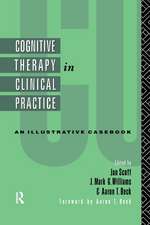Psychoeducational Groups: Process and Practice
Autor Nina W. Brownen Limba Engleză Hardback – 12 feb 2018
| Toate formatele și edițiile | Preț | Express |
|---|---|---|
| Paperback (1) | 432.48 lei 6-8 săpt. | |
| Taylor & Francis – 12 feb 2018 | 432.48 lei 6-8 săpt. | |
| Hardback (1) | 1097.96 lei 6-8 săpt. | |
| Taylor & Francis – 12 feb 2018 | 1097.96 lei 6-8 săpt. |
Preț: 1097.96 lei
Preț vechi: 1155.76 lei
-5% Nou
Puncte Express: 1647
Preț estimativ în valută:
210.09€ • 219.35$ • 173.88£
210.09€ • 219.35$ • 173.88£
Carte tipărită la comandă
Livrare economică 04-18 aprilie
Preluare comenzi: 021 569.72.76
Specificații
ISBN-13: 9781138049352
ISBN-10: 1138049352
Pagini: 328
Dimensiuni: 152 x 229 x 24 mm
Greutate: 0.51 kg
Ediția:4th edition
Editura: Taylor & Francis
Colecția Routledge
Locul publicării:Oxford, United Kingdom
ISBN-10: 1138049352
Pagini: 328
Dimensiuni: 152 x 229 x 24 mm
Greutate: 0.51 kg
Ediția:4th edition
Editura: Taylor & Francis
Colecția Routledge
Locul publicării:Oxford, United Kingdom
Public țintă
PostgraduateCuprins
List of Tables
List of Activities
Preface
Part I: Structuring
Chapter 1: Psychoeducation Groups: Overview and Model
Introduction
Advantages
Disadvantages
Myths and Misunderstandings
Group Leaders’ Expertise
Variety of Psychoeducational Groups
The KASST Model
The Role of Theories for Psychoeducational Groups
Research on Training Group Leaders
Overview of the Book
Chapter 2: Planning
Introduction
Phase 1: Information Gathering
Phase 2: Decisions About the Proposed Group
Phase 3: Preparing the Plan
Materials
Techniques
Chapter 3: Evaluation of the Group and Guidelines for Activities
Introduction
Rationale for Evaluation
Definition of Terms
Planning for Evaluation
Evaluating Goals, Objectives, and Strategies
Formative and Summative Evaluation
Standardized Instruments
Developing Data Gathering Instruments
Constructing a Data Gathering Instrument
Form Format
Assessing Attitudes and Perceptions
Experiential Activities
Guidelines and Planning for Experiential Group Activities
Chapter 4: Theories of Group Leadership and Instruction: The Cognitive Component for Dissemination of Information
Introduction
Theories of Group Leadership
Example of Application of a Theory to Psychoeducational Groups
Learning Preferences and Leadership Strategies
Leadership Strategy Clusters
Basic Principles of Learning
Principles of Instruction for Psychoeducational Groups
Taxonomy
Techniques
Part II: Leader Development and Facilitation Skills
Chapter 5: Group Leader Self-Development
Introduction
Rationale for Personal Growth Emphasis
Potential for Negative Countertransference
Self-Absorption or Underdeveloped Narcissism
Common Thoughts and Feelings Reflective of the Leader’s Self-Absorption and How to Reduce These
Effective Group Leader Characteristics
Group Leadership Attributes
Becoming Mindful
Chapter 6: Group Leadership Skills
Introduction
Group Leadership Skills
Group Level Skills
Group Level Skill Development Practice
Elements of Effective Communication
Developing Listening and Responding Skills
Listening and Responding Skills
Ineffective Communication
Questioning Skill Development
Chapter 7: The Group: Process and Progress
Introduction
Group Dynamics
Group Stages
Factors Most Likely to Appear
Factors Likely to Appear
Factors with Limited Appearance
Chapter 8: Cultural and Diversity Issues and Concerns
Introduction
Need and Rationale for Cultural and Diversity Competence
Training Standards
Culturally Sensitive Group Leaders
Microaggressions in Group: Implications for Narcissistic Injury
Prevention and Reduction of Microaggressions
Chapter 9: Ethical and Legal Standards
Ethical Standards
Do No Harm
A Duty to Protect
Laws, Codes, Regulations, and Practice Guidelines
Ethical Decision Making Models
Discussion: Examples of Ethical Dilemmas
Chapter 10: Potential Membership Problems, Concerns, and Intervention Skills
Introduction
Effective and Counterproductive Group Member Behaviors
Possible Sources for Member’s Difficult Behaviors
Involuntary Members
Ethical Guidelines for Involuntary Participants
Problem Member Behaviors and Their Goals
Under-Participation
The "Deviant" Group Member
Importance and Rationale for Identification of a Deviant Group Member
Deviant Behavior and Demeanor
Teaching Group Membership Skills
Specific Leadership Strategies
Chapter 11: Managing Conflict and Guidelines for Confrontation
Introduction
Characteristic Conflict Behavior
Variable Conflict Management Strategies
VCMS Members’ Dimensions
VCMS Strategies Based on Members’ Status
Description of Categories
Examples of Responses
A Conflict Resolution Procedure and Script
Confrontation
Major Types of Confrontation
Guidelines for Confrontation
Confronter, Receiver, and Condition Variables
Fundamentals of Confronting
Summary of Constructive Confrontation
Chapter 12: Leading Psychoeducational Groups for Children and Adolescents
Introduction
Types of Children’s Psychoeducational Groups
Research Finding for Children’s Groups
How Children’s Groups Differ
General Guidelines for Children’s Psychoeducational Groups
Sample Procedures and Structure for Sessions
Adolescent Groups
Characteristics of Adolescents
Leader Tasks
General Guidelines for Adolescent Psychoeducational Groups
Chapter 13: Leading Psychoeducational Groups for Adults
Introduction
Examples of Groups for Adults
Descriptions of Adult Groups
Sample Format for Meetings
Settings for Adult Psychoeducational Groups
A Basic Framework for Adult Groups
Guidelines for Adult Groups
An Example Plan
Chapter 14: Psychoeducational Groups for Illnesses and Other Conditions
Introduction
Characteristics for Groups for Illnesses and Other Conditions
Planning and Forming the Group
Members’ Attitudes and Behaviors That Can Affect the Group
A Single Session Model
Group Facilitation Considerations
Sample Plan for a Multisession Group
Chapter 15: Psychoeducational Self-Help and Support Groups, Manualized Groups
Introduction
Self-Help and Support Groups
Description of Psychoeducational Support Groups
Guidelines for Formal Learning
Background for Psychoeducational Support Groups
Designing Psychoeducational Support Groups
Manualized Groups
Virtual/Cyber Psychoeducational Support Groups
Bibliography
Index
List of Activities
Preface
Part I: Structuring
Chapter 1: Psychoeducation Groups: Overview and Model
Introduction
Advantages
Disadvantages
Myths and Misunderstandings
Group Leaders’ Expertise
Variety of Psychoeducational Groups
The KASST Model
The Role of Theories for Psychoeducational Groups
Research on Training Group Leaders
Overview of the Book
Chapter 2: Planning
Introduction
Phase 1: Information Gathering
Phase 2: Decisions About the Proposed Group
Phase 3: Preparing the Plan
Materials
Techniques
Chapter 3: Evaluation of the Group and Guidelines for Activities
Introduction
Rationale for Evaluation
Definition of Terms
Planning for Evaluation
Evaluating Goals, Objectives, and Strategies
Formative and Summative Evaluation
Standardized Instruments
Developing Data Gathering Instruments
Constructing a Data Gathering Instrument
Form Format
Assessing Attitudes and Perceptions
Experiential Activities
Guidelines and Planning for Experiential Group Activities
Chapter 4: Theories of Group Leadership and Instruction: The Cognitive Component for Dissemination of Information
Introduction
Theories of Group Leadership
Example of Application of a Theory to Psychoeducational Groups
Learning Preferences and Leadership Strategies
Leadership Strategy Clusters
Basic Principles of Learning
Principles of Instruction for Psychoeducational Groups
Taxonomy
Techniques
Part II: Leader Development and Facilitation Skills
Chapter 5: Group Leader Self-Development
Introduction
Rationale for Personal Growth Emphasis
Potential for Negative Countertransference
Self-Absorption or Underdeveloped Narcissism
Common Thoughts and Feelings Reflective of the Leader’s Self-Absorption and How to Reduce These
Effective Group Leader Characteristics
Group Leadership Attributes
Becoming Mindful
Chapter 6: Group Leadership Skills
Introduction
Group Leadership Skills
Group Level Skills
Group Level Skill Development Practice
Elements of Effective Communication
Developing Listening and Responding Skills
Listening and Responding Skills
Ineffective Communication
Questioning Skill Development
Chapter 7: The Group: Process and Progress
Introduction
Group Dynamics
Group Stages
Factors Most Likely to Appear
Factors Likely to Appear
Factors with Limited Appearance
Chapter 8: Cultural and Diversity Issues and Concerns
Introduction
Need and Rationale for Cultural and Diversity Competence
Training Standards
Culturally Sensitive Group Leaders
Microaggressions in Group: Implications for Narcissistic Injury
Prevention and Reduction of Microaggressions
Chapter 9: Ethical and Legal Standards
Ethical Standards
Do No Harm
A Duty to Protect
Laws, Codes, Regulations, and Practice Guidelines
Ethical Decision Making Models
Discussion: Examples of Ethical Dilemmas
Chapter 10: Potential Membership Problems, Concerns, and Intervention Skills
Introduction
Effective and Counterproductive Group Member Behaviors
Possible Sources for Member’s Difficult Behaviors
Involuntary Members
Ethical Guidelines for Involuntary Participants
Problem Member Behaviors and Their Goals
Under-Participation
The "Deviant" Group Member
Importance and Rationale for Identification of a Deviant Group Member
Deviant Behavior and Demeanor
Teaching Group Membership Skills
Specific Leadership Strategies
Chapter 11: Managing Conflict and Guidelines for Confrontation
Introduction
Characteristic Conflict Behavior
Variable Conflict Management Strategies
VCMS Members’ Dimensions
VCMS Strategies Based on Members’ Status
Description of Categories
Examples of Responses
A Conflict Resolution Procedure and Script
Confrontation
Major Types of Confrontation
Guidelines for Confrontation
Confronter, Receiver, and Condition Variables
Fundamentals of Confronting
Summary of Constructive Confrontation
Chapter 12: Leading Psychoeducational Groups for Children and Adolescents
Introduction
Types of Children’s Psychoeducational Groups
Research Finding for Children’s Groups
How Children’s Groups Differ
General Guidelines for Children’s Psychoeducational Groups
Sample Procedures and Structure for Sessions
Adolescent Groups
Characteristics of Adolescents
Leader Tasks
General Guidelines for Adolescent Psychoeducational Groups
Chapter 13: Leading Psychoeducational Groups for Adults
Introduction
Examples of Groups for Adults
Descriptions of Adult Groups
Sample Format for Meetings
Settings for Adult Psychoeducational Groups
A Basic Framework for Adult Groups
Guidelines for Adult Groups
An Example Plan
Chapter 14: Psychoeducational Groups for Illnesses and Other Conditions
Introduction
Characteristics for Groups for Illnesses and Other Conditions
Planning and Forming the Group
Members’ Attitudes and Behaviors That Can Affect the Group
A Single Session Model
Group Facilitation Considerations
Sample Plan for a Multisession Group
Chapter 15: Psychoeducational Self-Help and Support Groups, Manualized Groups
Introduction
Self-Help and Support Groups
Description of Psychoeducational Support Groups
Guidelines for Formal Learning
Background for Psychoeducational Support Groups
Designing Psychoeducational Support Groups
Manualized Groups
Virtual/Cyber Psychoeducational Support Groups
Bibliography
Index
Notă biografică
Nina W. Brown, PhD, is a professor and eminent scholar at Old Dominion University in Norfolk, VA. She received her doctorate from The College of William and Mary, is a member of the American Counseling Association and the Society of Group Psychology and Group Psychotherapy (APA Division 49), and a Fellow of the American Group Psychotherapy Association. Some of her 29 books include Teaching Group Dynamics; Expressive Processes for Group Counseling; Group Counseling for Middle and Elementary School Children; Psychoeducational Groups (now in its 4th edition); Becoming a Group Leader; Creative Activities for Group Therapy; The Destructive Narcissistic Pattern; Children of the Self-Absorbed (two editions); Loving the Self-Absorbed; and Coping with Infuriating, Mean, Critical People.
Recenzii
"From start to finish, this book contains the type of information that is absolutely critical to successfully intervening with students’ challenging behaviors. Mismanaged students’ behavior is a teacher’s Achilles heel, leading to burnout and a premature exodus from the profession. This book is more than a checklist menu of steps for creating a BIP. This book is full of gems, insights, and spot-on irreverent details—the underbelly of every school. Johnson’s interesting and creative, quirky storytelling drew me in and I absolutely could not put the book down. This book is one of a kind and I highly recommend it to every professional who develops behavior intervention plans. I plan on using this book as required reading for my school-based consultation class."
- Melissa A. Heath, PhD, NCSP, Professor, BYU School Psychology Program
- Melissa A. Heath, PhD, NCSP, Professor, BYU School Psychology Program
Descriere
With this fourth edition, Psychoeducational Groups remains the only comprehensive, user-friendly guide to planning, implementing, facilitating, and evaluating psychoeducational groups.






















